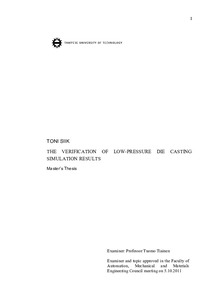The Verification of Low-pressure Die Casting Simulation Results
Siik, Toni (2011)
Siik, Toni
2011
Materiaalitekniikan koulutusohjelma
Automaatio-, kone- ja materiaalitekniikan tiedekunta - Faculty of Automation, Mechanical and Materials Engineering
This publication is copyrighted. You may download, display and print it for Your own personal use. Commercial use is prohibited.
Hyväksymispäivämäärä
2011-11-09
Julkaisun pysyvä osoite on
https://urn.fi/URN:NBN:fi:tty-201205221152
https://urn.fi/URN:NBN:fi:tty-201205221152
Tiivistelmä
In this thesis the accuracy of low-pressure die casting simulation results is both verified and improved for the casting process at Oras Oyj. The accuracy of casting simulation depends on the correctness of the initial data used for the simulation. This data include the process parameters and material data. As casting simulation programs only usually provide a limited database for the materials available on purchase it is often necessary to expand this database by modeling more materials and providing the correct process parameters of the simulated process.
The main goal of this project was to verify the correctness of the most important process parameters, material data and the actual results. With correct values the simulations can provide valuable information to the product designers and production. This information can be used to design better products and molds from the concept stage forwards. The simulation results can be used to improve old products.
The project was divided into two separate parts, theoretical and experimental sections. The theoretical section of the project concentrated on providing background information on the data which needed to be verified.
During the experimental section of the project, data was acquired which could be used to tune the simulation program. The data on casting alloys were improved by simulating the materials properties which were needed. These simulated properties were verified by using the thermal analysis of the casting alloys. The mold materials were tested at Jönköping University for the needed properties. All of these measurements were used to model the casting alloys and mold materials into the simulation programs database.
An experimental mold was also manufactured; this mold was used to measure the temperature-time curves inside the mold material during the casting cycles. The mold was used to cast test-castings of each different casting alloy which had to be simulated. The thermal data acquired from these test castings was compared to the simulated thermal data and the simulation program was adjusted until the results were comparable.
The accuracy of the simulation results was increased significantly due to the improved data acquired during this project. After this project simulation can be used as a tool in tool design and in finding the sources of quality problems. The data can still be improved by comparing the simulation results of more cases to the results obtained from real castings.
The main goal of this project was to verify the correctness of the most important process parameters, material data and the actual results. With correct values the simulations can provide valuable information to the product designers and production. This information can be used to design better products and molds from the concept stage forwards. The simulation results can be used to improve old products.
The project was divided into two separate parts, theoretical and experimental sections. The theoretical section of the project concentrated on providing background information on the data which needed to be verified.
During the experimental section of the project, data was acquired which could be used to tune the simulation program. The data on casting alloys were improved by simulating the materials properties which were needed. These simulated properties were verified by using the thermal analysis of the casting alloys. The mold materials were tested at Jönköping University for the needed properties. All of these measurements were used to model the casting alloys and mold materials into the simulation programs database.
An experimental mold was also manufactured; this mold was used to measure the temperature-time curves inside the mold material during the casting cycles. The mold was used to cast test-castings of each different casting alloy which had to be simulated. The thermal data acquired from these test castings was compared to the simulated thermal data and the simulation program was adjusted until the results were comparable.
The accuracy of the simulation results was increased significantly due to the improved data acquired during this project. After this project simulation can be used as a tool in tool design and in finding the sources of quality problems. The data can still be improved by comparing the simulation results of more cases to the results obtained from real castings.
